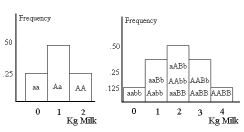
There is a continuum of traits being inherited as a Mendelian trait with simple inheritance and traits having
quantitative inheritance without well separated classes and with many genes involved.
Figure 1.2.
Classification of traits in relation to mode of inheritance and environmental tolerance.

|
Classification of traits in relation to mode of inheritance and environmental tolerance
are shown in Figure 1.2. First there are the well known traits with simple
Mendelian mode of inheritance.
The trait with quantitative genetic inheritance is caused by segregation of
many gene pairs, each with small
effect. At
the same time the trait is influenced by a lot of minor environmental effects.
Diseases will often be 'either/or traits' as the simple Mendelian traits. Cases
in which the severity of the
disease has a normal distribution can also be found. In many production diseases the disease
only occurs when a genetically prone
individual is exposed to adverse environmental effects. See Figure 1.2, produced
by prof. emeritus Erik
Andresen.
Figure 1.3. Illustrating how one and two gene pairs can influence
milk yields. In reality, numerous gene pairs have to be
involved for selection to be
carried out generation after generation without the genetic variation diapers when selecting .
 |
Figure 1.3 gives an illustration of how one or two Mendelian segregating gene pairs control the milk yield. For each A or B allele an individual has a yield increase of one kilogram. The alleles A and a have the same frequency in the distributions. For a realistic picture of the genetic background for milk yields, hundreds of gene pairs have to be involved. The milk yield has by selection been changed just as dramatically as the fat-% in the milk, as shown in section 1.4. To make this possible there has to be an effect from numerous gene pairs. In the present example using only two gene pairs, they could be fixed after one generation of selection.